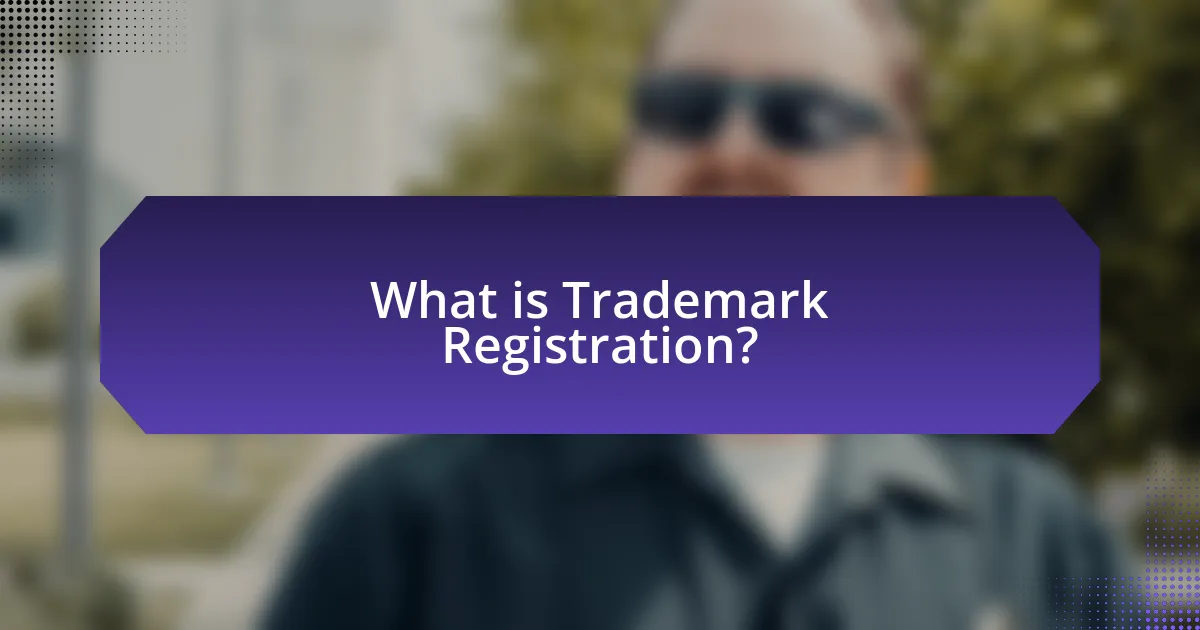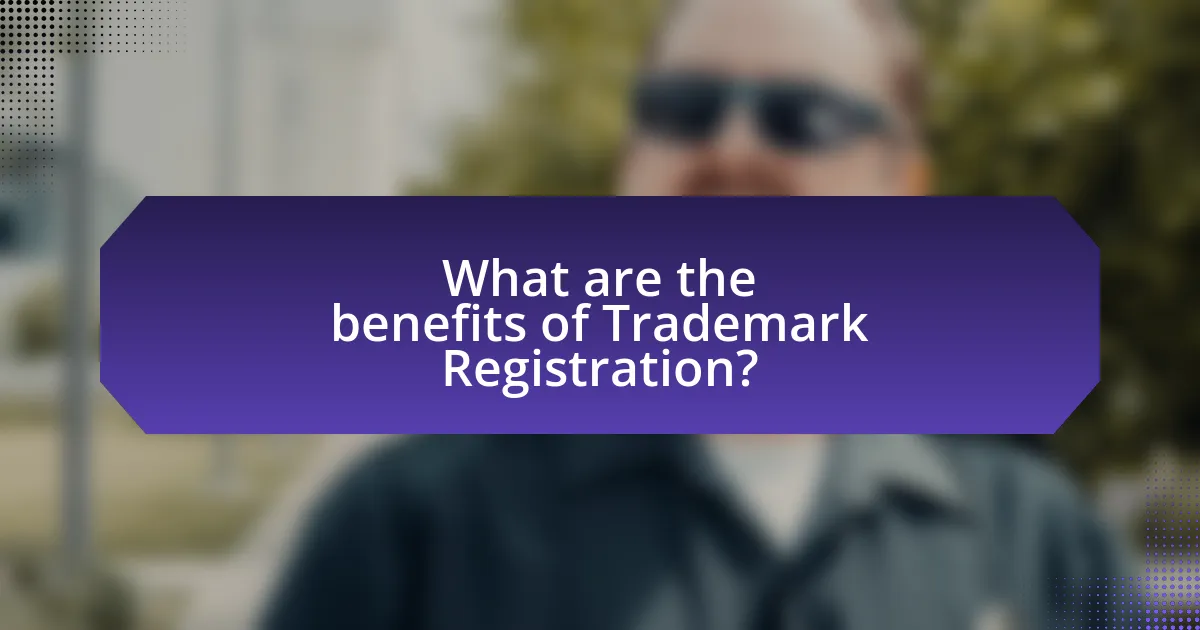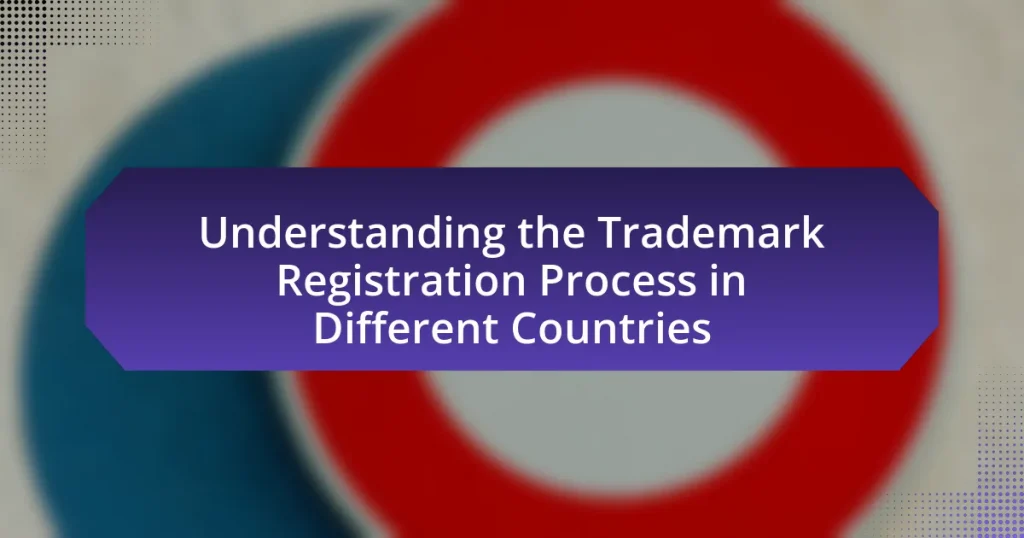Trademark registration is the legal process of officially recording a trademark with a governmental authority to protect a brand’s identity for goods or services. This article provides a comprehensive overview of trademark registration, including its importance, legal protections, and the impact on brand identity. Key components of the registration process, types of trademarks, and common challenges faced during registration are discussed. Additionally, the article outlines the benefits of trademark registration for businesses, including enhanced brand value and marketability, as well as best practices for ensuring effective trademark protection.

What is Trademark Registration?
Trademark registration is the legal process of officially recording a trademark with a governmental authority to protect the brand identity of goods or services. This process grants the trademark owner exclusive rights to use the mark in commerce, preventing others from using a similar mark that could cause confusion among consumers. In the United States, for example, the United States Patent and Trademark Office (USPTO) oversees this registration, which involves submitting an application that includes the trademark, the goods or services it will represent, and a specimen showing the mark in use. Successful registration provides legal advantages, such as the presumption of ownership and the right to sue for infringement.
Why is Trademark Registration important?
Trademark registration is important because it provides legal protection for a brand’s identity, preventing unauthorized use by others. This legal protection helps businesses establish their brand in the marketplace, enhances their reputation, and can lead to increased customer trust. Additionally, registered trademarks can be enforced in court, allowing the owner to take legal action against infringers. According to the United States Patent and Trademark Office, registered trademarks can also serve as valuable business assets, potentially increasing the overall value of a company.
What legal protections does Trademark Registration provide?
Trademark registration provides legal protections such as exclusive rights to use the trademark in commerce, preventing others from using a similar mark that could cause confusion. This exclusivity is enforced through legal action against infringers, allowing the trademark owner to seek damages and injunctions. Additionally, registered trademarks can enhance brand value and provide a presumption of ownership and validity in legal disputes, as established by the Lanham Act in the United States.
How does Trademark Registration impact brand identity?
Trademark registration significantly enhances brand identity by providing legal protection and exclusivity to a brand’s name, logo, or slogan. This legal recognition helps consumers easily identify the source of goods or services, fostering trust and loyalty. According to the United States Patent and Trademark Office, registered trademarks can increase a brand’s value and marketability, as they signify quality and reliability to consumers. Furthermore, trademark registration deters competitors from using similar marks, thereby reducing confusion in the marketplace and solidifying a brand’s unique identity.
What are the key components of Trademark Registration?
The key components of Trademark Registration include the application process, the trademark search, the examination of the application, publication for opposition, and the issuance of the registration certificate. The application process requires submitting a detailed form that includes the trademark, the goods or services it will represent, and the applicant’s information. A trademark search is conducted to ensure that the proposed trademark does not conflict with existing trademarks, which is crucial for avoiding legal disputes. The examination phase involves a review by the trademark office to assess compliance with legal requirements and potential conflicts. Following this, the trademark is published for opposition, allowing third parties to contest the registration. Finally, if no opposition arises, a registration certificate is issued, granting the trademark owner exclusive rights to use the mark in commerce. These components are essential for establishing and protecting trademark rights effectively.
What types of trademarks can be registered?
The types of trademarks that can be registered include standard character marks, stylized/design marks, service marks, collective marks, and certification marks. Standard character marks protect words, letters, numbers, or any combination thereof without regard to font, style, size, or color. Stylized/design marks protect specific visual representations of a brand, including logos. Service marks are similar to trademarks but specifically identify and distinguish services rather than goods. Collective marks indicate membership in an organization, while certification marks signify that goods or services meet certain standards. These classifications are recognized by the United States Patent and Trademark Office, which provides guidelines for the registration process.
What is the process for applying for a trademark?
The process for applying for a trademark involves several key steps. First, an applicant must conduct a trademark search to ensure that the desired trademark is not already in use or registered by another entity. Next, the applicant completes and submits a trademark application to the relevant government authority, such as the United States Patent and Trademark Office (USPTO) in the United States. This application includes details about the trademark, the goods or services it will represent, and the applicant’s information. After submission, the application undergoes examination by a trademark examiner, who assesses its compliance with legal requirements. If approved, the trademark is published for opposition, allowing third parties to contest the registration. If no opposition is filed or if opposition is resolved in favor of the applicant, the trademark is registered, granting the applicant exclusive rights to use the mark in commerce. This process is supported by the Lanham Act, which governs trademark registration in the United States.

How does the Trademark Registration process work?
The Trademark Registration process involves several key steps to secure legal protection for a brand’s name, logo, or slogan. Initially, an applicant must conduct a trademark search to ensure that the desired mark is not already in use or registered by another entity. Following this, the applicant submits a trademark application to the relevant government authority, such as the United States Patent and Trademark Office (USPTO), which includes details about the mark and the goods or services it will represent.
Once the application is filed, it undergoes examination by a trademark examiner who assesses its compliance with legal requirements. If the application meets all criteria, it is published in an official gazette, allowing third parties to oppose the registration if they believe it conflicts with their existing trademarks. If no opposition is filed or if any opposition is resolved in favor of the applicant, the trademark is registered, granting the owner exclusive rights to use the mark in commerce.
This process is supported by legal frameworks established in various jurisdictions, such as the Lanham Act in the United States, which outlines the procedures and protections associated with trademark registration.
What steps are involved in Trademark Registration?
The steps involved in trademark registration include conducting a trademark search, filing an application with the relevant trademark office, responding to any office actions, and finally, receiving the trademark registration certificate. Conducting a trademark search helps to ensure that the desired trademark is not already in use, which is crucial for avoiding potential legal conflicts. Filing the application involves submitting the necessary forms and fees to the trademark office, which varies by jurisdiction. If the trademark office raises any concerns or requires additional information, responding to office actions is necessary to address those issues. Once the application is approved, the trademark registration certificate is issued, granting the owner exclusive rights to the trademark.
How do you conduct a trademark search?
To conduct a trademark search, start by identifying the specific trademark you wish to search for, including its name and any relevant design elements. Next, utilize the United States Patent and Trademark Office (USPTO) Trademark Electronic Search System (TESS) to search for existing trademarks that may be similar or identical. This database allows users to check registered trademarks and pending applications. Additionally, consider searching state trademark databases and online resources to ensure comprehensive coverage. According to the USPTO, conducting a thorough search helps avoid potential legal conflicts and ensures the trademark’s availability for registration.
What documents are required for the application?
The documents required for a trademark application typically include a completed application form, a representation of the trademark, and a list of goods or services associated with the trademark. Additionally, applicants may need to provide proof of use of the trademark in commerce or an intent-to-use declaration if the trademark is not yet in use. These requirements are established by trademark offices, such as the United States Patent and Trademark Office (USPTO), which outlines specific documentation needed for successful registration.
What are the common challenges in Trademark Registration?
Common challenges in trademark registration include the likelihood of confusion with existing trademarks, the complexity of the application process, and the potential for opposition from third parties. The likelihood of confusion arises when a new trademark is similar to an already registered one, which can lead to rejection by trademark offices. The application process is often intricate, requiring detailed descriptions and classifications of goods or services, which can be difficult for applicants to navigate. Additionally, third parties may oppose a trademark application during the publication phase, leading to legal disputes that can delay or prevent registration. These challenges highlight the importance of conducting thorough trademark searches and seeking legal advice to enhance the chances of successful registration.
What are the reasons for trademark application rejections?
Trademark applications can be rejected for several reasons, including lack of distinctiveness, similarity to existing trademarks, and failure to comply with legal requirements. Lack of distinctiveness occurs when a mark is too generic or descriptive, making it difficult for consumers to identify the source of the goods or services. Similarity to existing trademarks can lead to confusion among consumers, which is a primary reason for rejection. Additionally, applications may be rejected if they do not meet specific legal standards, such as improper classification of goods or services or failure to provide adequate specimens of use. These reasons are grounded in trademark law, which aims to protect both consumers and trademark owners by ensuring clarity and preventing market confusion.
How can disputes over trademarks be resolved?
Disputes over trademarks can be resolved through negotiation, mediation, arbitration, or litigation. Negotiation involves the parties directly discussing their differences to reach a mutually acceptable agreement. Mediation employs a neutral third party to facilitate discussions and help the parties find common ground. Arbitration is a more formal process where an arbitrator makes a binding decision based on the evidence presented. Litigation involves taking the dispute to court, where a judge or jury will make a final ruling. Each method has its own advantages and can be chosen based on the specifics of the dispute, such as complexity and the relationship between the parties.

What are the benefits of Trademark Registration?
Trademark registration provides legal protection for a brand’s identity, allowing the owner exclusive rights to use the trademark in commerce. This exclusivity helps prevent unauthorized use by competitors, thereby safeguarding the brand’s reputation and market position. Additionally, registered trademarks can enhance business value, as they are considered intellectual property that can be sold or licensed. According to the United States Patent and Trademark Office, registered trademarks can also serve as a basis for international trademark protection, facilitating global business expansion.
How does Trademark Registration enhance business value?
Trademark registration enhances business value by providing legal protection for brand identity, which helps to establish consumer trust and loyalty. When a business registers its trademark, it gains exclusive rights to use that mark in commerce, preventing competitors from using similar identifiers that could confuse consumers. This exclusivity can lead to increased market share and pricing power, as consumers are more likely to choose a recognized and trusted brand. Additionally, registered trademarks can be valuable assets, contributing to the overall valuation of a business during mergers, acquisitions, or investment opportunities. According to the International Trademark Association, businesses with registered trademarks report higher revenue growth compared to those without, underscoring the financial benefits of trademark registration.
What role does Trademark Registration play in marketing strategies?
Trademark registration plays a crucial role in marketing strategies by providing legal protection for brand identity, which enhances consumer trust and brand recognition. When a business registers its trademark, it secures exclusive rights to use that mark in connection with its goods or services, preventing competitors from using similar identifiers that could confuse consumers. This legal safeguard not only helps in establishing a unique market presence but also strengthens brand loyalty, as consumers are more likely to purchase from a recognized and protected brand. According to the United States Patent and Trademark Office, registered trademarks can increase a company’s valuation and marketability, making them a vital component of effective marketing strategies.
How can Trademark Registration prevent infringement?
Trademark registration prevents infringement by providing legal protection for a brand’s unique identifiers, such as names, logos, and slogans. This legal status grants the trademark owner exclusive rights to use the mark in commerce, thereby deterring unauthorized use by others. According to the United States Patent and Trademark Office, registered trademarks can be enforced in court, allowing the owner to seek damages and injunctions against infringers. Additionally, registration serves as public notice of ownership, reducing the likelihood of unintentional infringement by third parties.
What are the long-term implications of Trademark Registration?
The long-term implications of trademark registration include enhanced legal protection, brand recognition, and potential revenue generation. Trademark registration provides exclusive rights to use the mark in commerce, which helps prevent unauthorized use by competitors. This legal protection can lead to increased consumer trust and loyalty, as registered trademarks are often perceived as more credible. Additionally, a registered trademark can appreciate in value over time, becoming a significant asset for the business. According to the United States Patent and Trademark Office, registered trademarks can also facilitate easier enforcement of rights in case of infringement, thereby safeguarding the brand’s reputation and market position.
How does Trademark Registration affect business expansion?
Trademark registration significantly enhances business expansion by providing legal protection for brand identity, which fosters consumer trust and loyalty. When a business registers its trademark, it secures exclusive rights to use that mark in commerce, preventing competitors from using similar branding that could confuse consumers. This legal safeguard allows businesses to invest in marketing and expansion strategies with confidence, knowing their brand is protected. According to the International Trademark Association, businesses with registered trademarks are 50% more likely to experience growth in revenue and market share compared to those without. Thus, trademark registration not only protects a business’s intellectual property but also serves as a catalyst for sustainable growth and market presence.
What are the renewal requirements for registered trademarks?
Registered trademarks must be renewed periodically, typically every ten years, to maintain their protection. The renewal process requires the trademark owner to file a renewal application with the relevant trademark office, such as the United States Patent and Trademark Office (USPTO), and pay the associated renewal fee. Additionally, the owner must demonstrate continued use of the trademark in commerce, which may involve submitting a declaration of use or proof of use, depending on the jurisdiction. Failure to meet these requirements can result in the cancellation of the trademark registration.
What best practices should be followed for Trademark Registration?
To ensure successful trademark registration, it is essential to conduct a comprehensive trademark search to identify existing trademarks that may conflict with your desired mark. This search helps avoid potential legal disputes and rejections from the trademark office. Additionally, applicants should clearly define the goods or services associated with the trademark, as specificity aids in the registration process and protects the brand effectively.
Filing the application accurately and completely is crucial; errors or omissions can lead to delays or denials. It is also advisable to seek legal counsel or assistance from a trademark attorney, as they can provide expertise in navigating the complexities of trademark law and increase the likelihood of successful registration.
Finally, maintaining the trademark through regular renewals and monitoring for potential infringements is vital to preserving the rights associated with the trademark. According to the United States Patent and Trademark Office, approximately 50% of trademark applications are rejected due to improper filing or lack of distinctiveness, underscoring the importance of following these best practices.
How can businesses ensure their trademarks are protected effectively?
Businesses can ensure their trademarks are protected effectively by registering them with the appropriate governmental authority, such as the United States Patent and Trademark Office (USPTO). Registration provides legal recognition and exclusive rights to use the trademark in commerce, which helps prevent unauthorized use by others. Additionally, businesses should actively monitor the market for potential infringements and enforce their rights through legal action if necessary. According to the USPTO, registered trademarks can significantly enhance a business’s ability to defend its brand and maintain its reputation in the marketplace.
What resources are available for navigating the Trademark Registration process?
The resources available for navigating the Trademark Registration process include the United States Patent and Trademark Office (USPTO) website, which provides comprehensive guides, application forms, and FAQs. Additionally, the USPTO offers a Trademark Electronic Application System (TEAS) for online submissions, and educational webinars to assist applicants. Legal professionals specializing in intellectual property can also serve as valuable resources, providing personalized guidance and expertise in the registration process. Furthermore, various online platforms and organizations, such as the International Trademark Association (INTA), offer tools, articles, and networking opportunities to help individuals understand and navigate trademark registration effectively.



